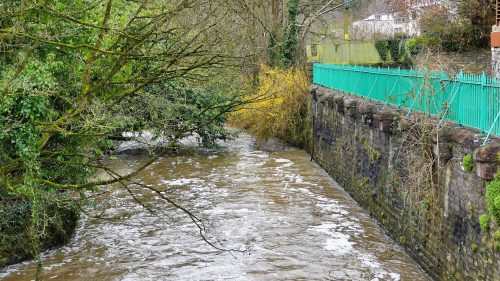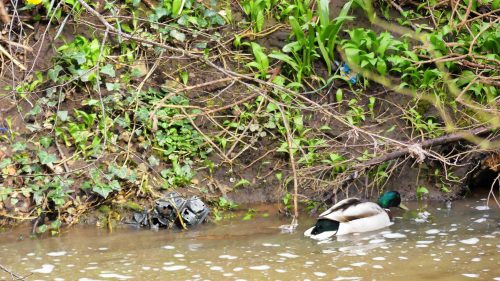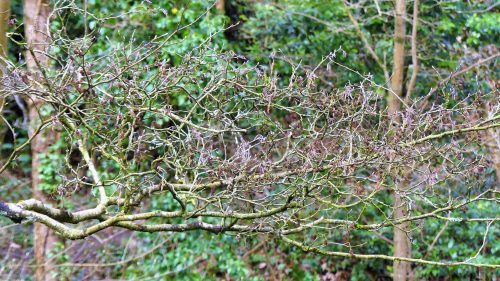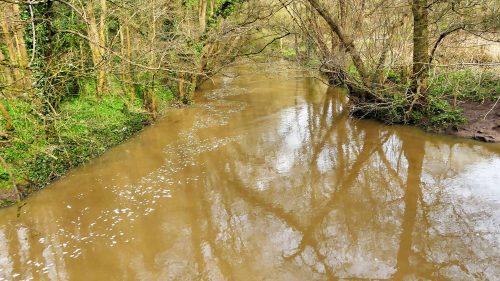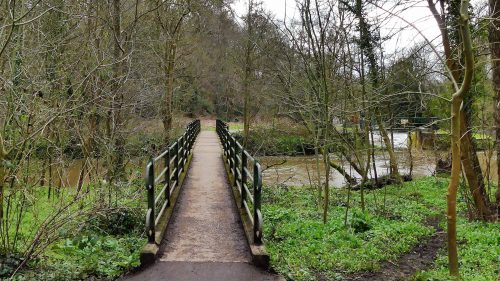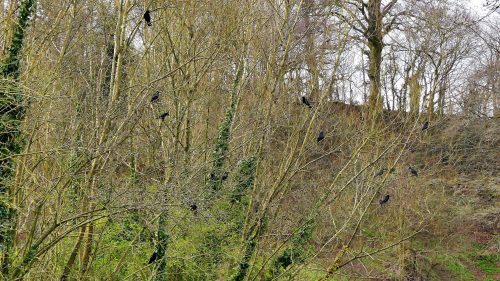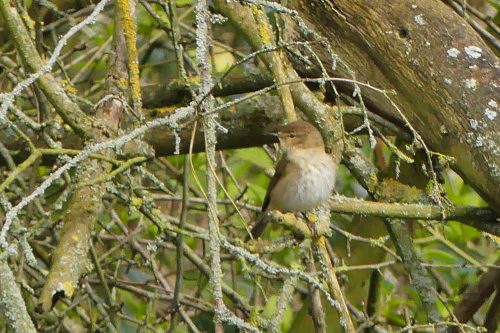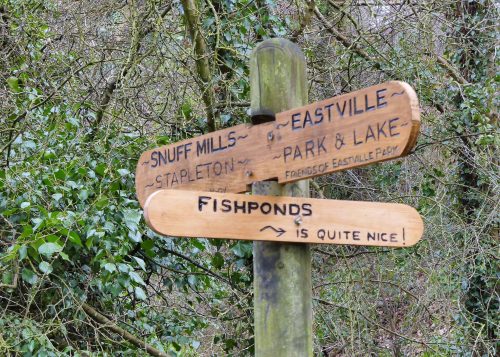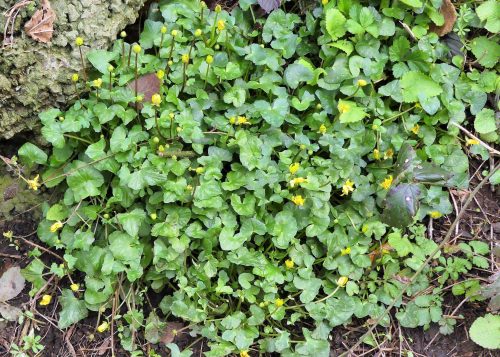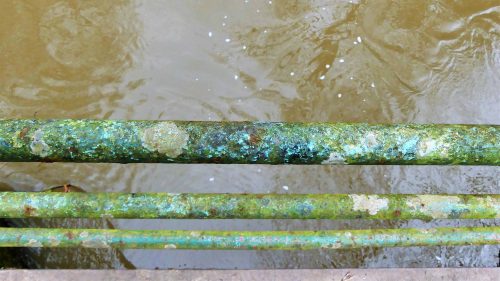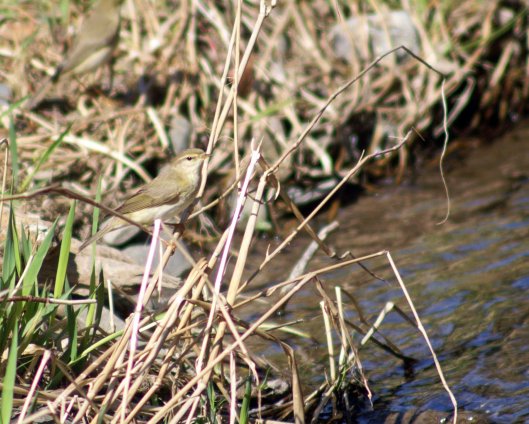Tags
ashy mining bee, Bee-fly, Blackcap, blackthorn blossom, Chiffchaff, comma, cowslip, Greater Spotted Woodpecker, hairy-footed flower bee, tawny mining bee, tree bumblebee
April 19th – Bryn Euryn
Today was the middle day of the three consecutively warm sunny days that tantalised us with the notion that Spring had truly arrived, and judging by the activity here today it had a lot of our wildlife fooled too. The sky was clear and that almost-unbelievable shade of deep blue, the birds were singing and best of all, it was warm!
A few metres along the Woodland Path of my patch is an untidy-looking stretch, divided by the narrow path, where missing trees have opened up the canopy, letting in the light and warmth of the sun. Somewhat mysteriously, it holds great allure for diverse species of insects, some of which at certain times can be found here in surprising numbers. At the right time on the right day, ten minutes spent in this ‘hotspot’ can be as productive as two hours spent ranging over the rest of the site.
11:44 Today I was here at the right time to see a surprising amount of insects. Most prolific were hoverflies in all shapes and sizes from big and bulky to teeny-tiny and dainty.
There were few flowers here for nectaring upon, so that wasn’t the attraction for the majority of the hoverflies; I caught just one on the tiny flowers of Dog’s mercury. There were dozens of this small black and yellow striped species here, all very fresh and shiny and mostly basking on the sun-warmed leaves of brambles and nettles.
One side of the ‘hotspot’ is open to sunlight, clear of trees but sheltered by those standing behind it and by large shrubs of laurel and holly on either side. A large tangle of bramble fills the gap in the vegetation and is the only barrier between you and the Expressway below at the bottom of an almost-vertical slope. (Only joking, there’d be plenty of trees to stop you if you fell!) On the other side is a large patch of nettles, the aforementioned Dog’s mercury, more bramble and a pretty patch of periwinkle, all growing through a ground-covering of ivy.
A lone Tree bumblebee flew in, visited a couple of the periwinkle flowers then stopped to bask on a last-year’s half-eaten bramble leaf. I think it was a male (no pollen baskets) and was looking a bit the worse for wear. He seemed to have a burden of mites and I wondered if exposing them to warm sun might dislodge them. I’ve seen birds do that.
A smaller bee caught my eye as it came to rest on an ivy leaf. I didn’t realise what it was until I saw my photograph, then was excited to see it was a Hairy-footed Flower Bee, this one a male and my first record of this species here.
Hairy-footed Flower Bee (m)-Anthophora plumipes
A species common and widespread in much of England and Wales, especially in towns, cities and villages. Often nests in the soft mortar and exposed cob of old walls, but occasionally will nest in the ground, preferring bare compacted clay soils. Flies from late February to mid-June, and is particularly partial to Lungwort (Pulmonaria) flowers.
Males and females look very different from one another: the female resembles a small, black bumblebee with orange-red hairs on the hind leg and a rapid-darting flight; she’ll often approach a flower with her long tongue extended. Males are mostly brown with a dark tail (fresh specimens are gingery). Cream markings on face distinguish it from all bumblebees.They are often among the first bees of the year to emerge and often hover in front of flowers and when pursuing females.
Another little bee came to rest on a nettle leaf, this one I recognised as an Ashy mining bee and another male.
Ashy mining bee (m)-Andrena cineraria
A distinctive and obvious spring-flying solitary bee. Females are black, and have two broad ashy-grey hairbands across the thorax. Males emerge well before the females. They look similar, but their thorax is entirely covered with less dense grey hairs, and there’s a pronounced tuft of white hairs on the lower face. Species has a single flight period each year from early April until early June. Nests are constructed in the ground; entrances are surrounded by a volcano-like mound of excavated spoil; often in dense aggregations in lawns, flower beds, mown banks and in field margins.
And where there are mining bees there are those who would prey upon them….. Bee-flies: quirkily-cute in appearance but not good to know if you’re a hard-working mining bee; they’ll spy out your nest-hole and craftily kick their eggs inside with those long legs, then later their hatched larvae will feast on yours.
Wasps were out on the prowl too; I didn’t get a clear enough image to tell if this was a German or Common Wasp – the latter have a distinctive anchor mark on their face; this image is a bit fuzzy.
12:07 I could have lingered longer, but birds were singing, I’d been serenaded by a Song thrush and a Robin as I stood watching insects, Blue tits twittered on all sides and I was keen to see what else was happening.
Bluebells are beginning to flower and offer nectar to those that can reach it, there’s also Greater Stitchwort and lots of Dog Violets. A male Orange-tip butterfly raced past me over the bluebells and through the trees, clearly on the trail of a female and not stopping for an instant.
There are masses of glorious glossy golden yellow lesser celandines shining in the sunlight too.
I stopped to admire the celandines lining a section of the path and not at all concerned by my presence, a Blue tit perched above me and began to sing.
Beneath him dozens of shiny new flies arrived to bask on soft sun-warmed new bramble leaves.
There’s one special spot I know where Wood Anemones light up the woodland floor like fallen stars, turning their faces to the sun
and another where those of the shamrock-leaved Wood sorrel shyly hide theirs.
Over the boundary fence, the formidable thorny boundary hedge of gorse and blackthorn is softened now with their fragrant gold and white blossoms.
I heard a bird singing, a short loud burst of notes that I thought at first was a Wren, but it wasn’t quite right. I’d forgotten that another tiny bird, the Goldcrest also has a disproportionately loud song, remembering when he broke cover and flitted about in shrubbery in front of me. He wasn’t going to oblige me with a photograph, much too busy! So I stood gazing upwards for a while – you can’t get too much beautiful blue sky…
… or pretty blossom, can you?
WOODLAND TRAIL
12:58 There’s another hotspot around the junction of my Woodland Path with the reserve’s Woodland Trail, this one for birds. Here there is a territory of both Blackcap and Chiffchaff so there is the possibility of hearing if not seeing both species here. Today I was lucky; I heard the Blackcap’s song as I approached and walking slowly and as quietly as I was able I spotted him. He continued to sing but moved restlessly through the branches as I got nearer then flew off across the other side of the track.
While he sang from behind foliage over there I watched a pretty female Tawny mining bee feast on Blackthorn blossom.
Then the Blackcap came back to where he’d started, so I think perhaps his red-headed mate may be on their nest somewhere close by.
This gorgeous gorse is below his singing tree. It would make a safe place to nest and the flowers would attract insects for dinner.
I had heard a Chiffchaff singing nearby too but was pleasantly surprised when he appeared, continuing his song while flitting about amongst the twiggy branches searching for insects.
13:21 Further along the trail I spotted a flutter of orange – a lovely fresh Comma butterfly basking on dry leaves at the edge of the path. As I watched it moved, (look away now if you’re squeamish) onto a thankfully dryish dog poo deposit. I had to take the picture as it nicely presented its underside showing off the distinctive white mark for which it is named.
The disturbed ground of the pathsides supports some of the ‘weedier’ wildflowers like dandelions which provide important nectar when there’s not much else in flower.
You’d be very unlucky not to hear and see a Robin singing along here, there seems to be one at regularly spaced intervals. They sit and watch out over the track then dart out to pounce on any potential prey they may spot. This one had been singing but stopped to watch me.
 I waited to see if he’d start singing again and was distracted by a bird whistling loudly. I scanned around searching for whatever was making the sound, one I didn’t recognise at all but that sounded to be being made by quite a large bird. After a few minutes the whistler appeared and to my amusement turned out to be …. a Great Tit! Of course it was, one of the basics of birdsong recognition is ‘when you don’t recognise it or haven’t heard it before, chances are it’ll be a Great Tit’; they have an incredible repertoire of sounds to call upon. I was thankful to him for keeping me in that spot though, as this gorgeous Greater Spotted Woodpecker flew onto a tree trunk literally right in front of me.
I waited to see if he’d start singing again and was distracted by a bird whistling loudly. I scanned around searching for whatever was making the sound, one I didn’t recognise at all but that sounded to be being made by quite a large bird. After a few minutes the whistler appeared and to my amusement turned out to be …. a Great Tit! Of course it was, one of the basics of birdsong recognition is ‘when you don’t recognise it or haven’t heard it before, chances are it’ll be a Great Tit’; they have an incredible repertoire of sounds to call upon. I was thankful to him for keeping me in that spot though, as this gorgeous Greater Spotted Woodpecker flew onto a tree trunk literally right in front of me.
 The Woodpecker stayed there, keeping a watchful eye on me. This bird is a female and is holding something small in her beak, so I imagine she has a nest nearby and was unwilling to reveal it. I moved away quickly, thanking her for the photo opportunity as I did.
The Woodpecker stayed there, keeping a watchful eye on me. This bird is a female and is holding something small in her beak, so I imagine she has a nest nearby and was unwilling to reveal it. I moved away quickly, thanking her for the photo opportunity as I did.
Great Spotted Woodpeckers are about the same size as Starlings. Their plumage denotes their age and sex. Juvenile birds have red foreheads that are replaced by black as they moult in the autumn. Adult males then have a red nape while females have no red on their head at all.
The Lesser Celandines have been late flowering this Spring but are glorious now and more prolific than I’ve seen them before. It’s not just the flowers that are prolific, so too were hoverflies and Bee-flies seemed to be everywhere.
Approaching the entrance to the meadow another Robin, which looks as though it is singing, but was actually ‘ticking me off’, let me know it didn’t appreciate my disturbing it.
THE UPPER MEADOW (ADDER’S FIELD)
The grass of the meadow was cut back hard last autumn and so far there’s not much happening there yet, but the grass is beginning to grow and the cowslips are starting to come out. They’ll be later on the more exposed ‘downland’ side of the hill.
Another Bee-fly settled on an exposed rock in the pathway, fluttering its wings rapidly and making flicking movements with its legs as they do when depositing their eggs, but there was no sign of a mining bee nest anywhere near, so not sure what it was doing.
Summer Rainfall Prediction:
If oak is out before the ash, there’ll be a splash ; if ash is out before the oak there’ll be a soak…
Keep the brollies handy, looks like ash is furthest on so far….!
Wriggling across the still-damp ground on the way to the Summit Trail was an earthworm. Double jeopardy came to mind – exposure to warm sunshine and hungry birds; foolish worm.
Last year I noticed spots along the trail here where Mining Bees were making nests. having seen a few about today I kept an eye out for more signs of their activity and spotted these little ‘volcanoes’, evidence of their presence. I waited a while but no bees showed, so I don’t know which species had made them, but I think maybe Tawny Mining Bees.
THE SUMMIT
It was cooler and breezier up here. I walked carefully, hoping there may be Small Tortoiseshell butterflies basking on the bare earth of the path, but not today, although I did see two busily chasing one another at speed as they disappeared over the edge of the cliff.
The mountains and the distant Conwy valley were veiled by a misty haze.
The blackthorn is smothered with blossom and looking beautiful. It will be interesting to see how much of it gets pollinated and develops as fruit this autumn. Sloe gin comes to mind.
The path back down to the Woodland Trail felt almost bridal with falling petals showering down onto the ground like confetti. A pretty way to end this account of a lovely walk.
































































